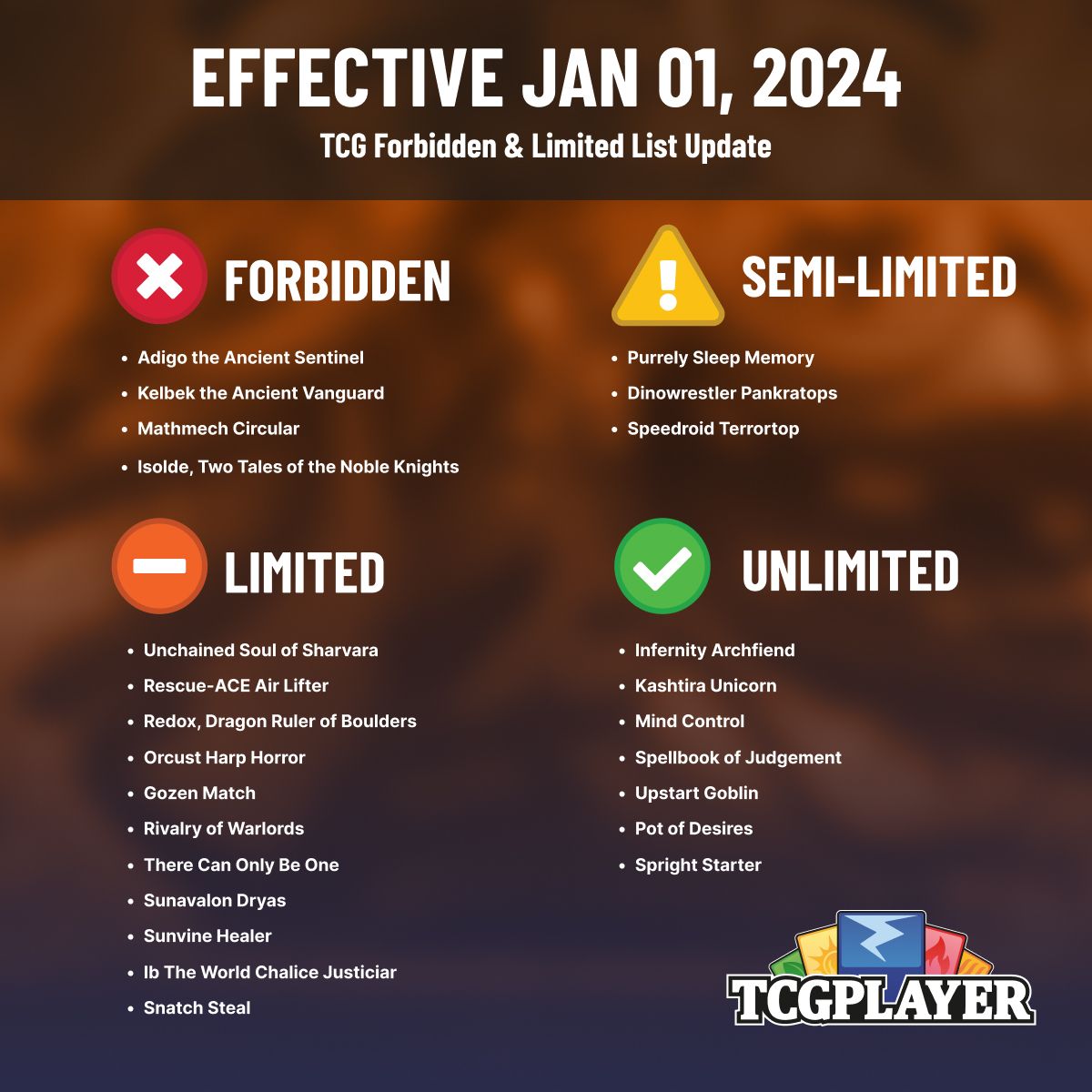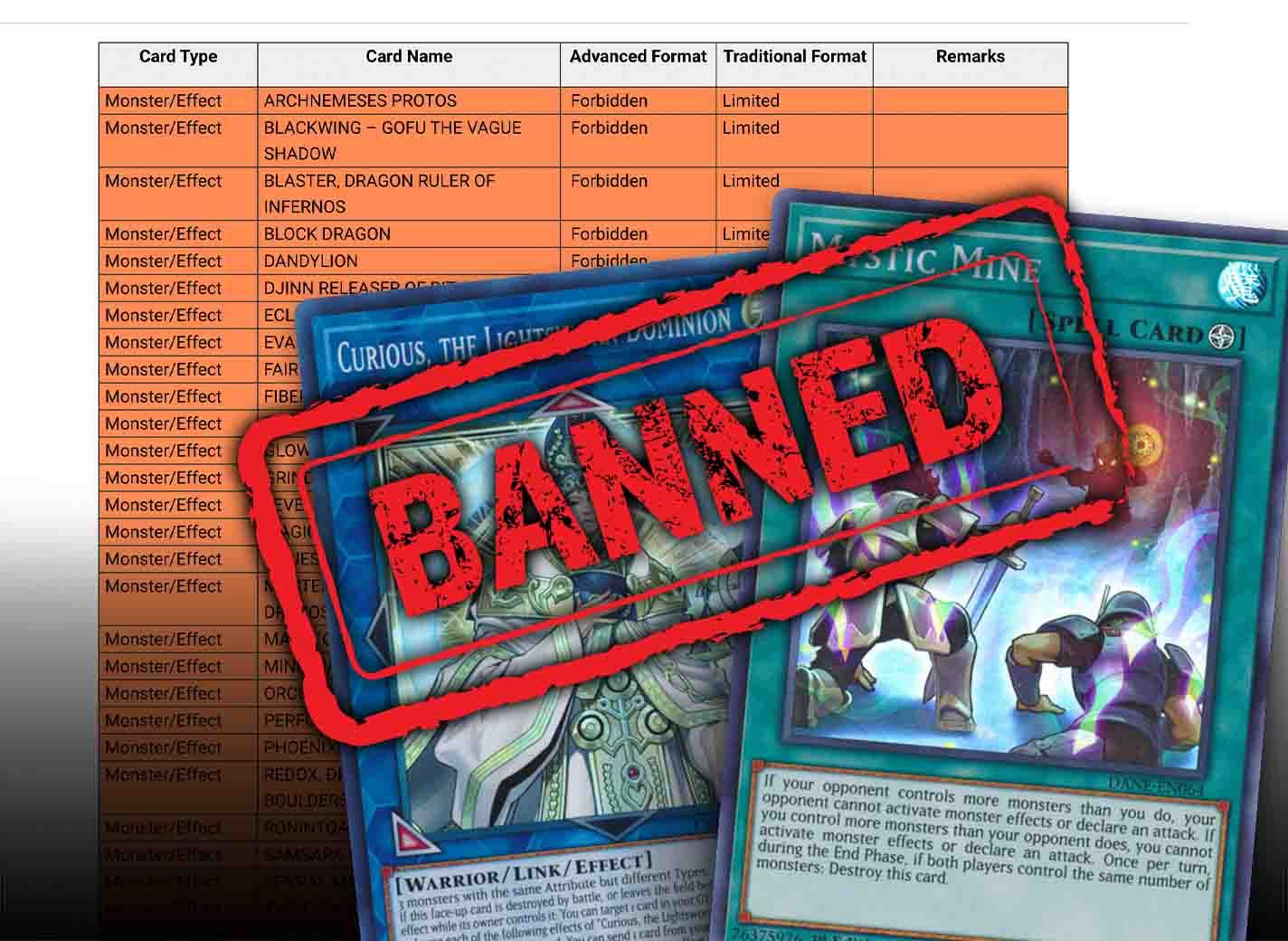Yu-Gi-Oh players often feel a unique mix of excitement and a little bit of nervousness when new updates come around, especially for the banlist. It's that time again, you know, when the game's official rule setters, Konami, shake things up a bit, deciding which cards get to stay and which ones need a time-out. This feeling, well, it's pretty much a regular part of being involved with the trading card game. Every so often, the folks in charge make some choices that really shift how people play, making sure the duels stay fair and interesting for everyone who enjoys throwing down cards.
These lists, you see, are super important for keeping the game fair and fun for everyone, making sure no single strategy gets too strong or dominates the playing field. They really help keep things fresh, too, giving players a chance to try out new card combinations and approaches. Without these periodic adjustments, a few very powerful cards or combos might just take over, making every game feel the same, which would get boring rather quickly for a lot of people. It’s all about keeping that sense of discovery and challenge alive, giving everyone a fair shake at winning.
So, if you're curious about the latest changes or just want to get a better handle on how these lists work, this is the spot for you. We'll go over the recent announcements and what they mean for your favorite card duels. We'll talk about what cards are now off limits or limited, and how these decisions impact the various ways you might build your collection of cards or put together your battle-ready decks. It's basically a way to make sure everyone is on the same page and can keep enjoying the game with all the new adjustments in place.
Table of Contents
- What's the Latest on the Yu-Gi-Oh Banlist?
- Why Do We Even Have a Banlist Yu-Gi-Oh?
- How Does the Yu-Gi-Oh Banlist Work?
- The Forbidden Cards on the Yu-Gi-Oh Banlist
- The Limited Cards on the Yu-Gi-Oh Banlist
- Keeping Your Decks Ready for the Yu-Gi-Oh Banlist
- Where Can I Find the Official Yu-Gi-Oh Banlist?
- What This Banlist Yu-Gi-Oh Means for You
What's the Latest on the Yu-Gi-Oh Banlist?
The card game community, you know, really looks forward to these regular updates for the forbidden and limited list, and the most recent adjustments have just been made public. These new rules started on April 7, 2025, and Konami, the company behind the game, shared all the details during the final matches at YCS Houston on April 6. It was quite a moment, with everyone watching to see what big changes were coming. These announcements are a big deal for everyone who plays, especially those who like to compete in events, as they really shape how the game plays out in the months ahead. It’s a pretty exciting time for players to figure out new strategies.
The list that just came out covers all sorts of cards, so, you'll find adjustments for your monster cards, the spell cards you cast, the trap cards you set, and even those powerful fusion cards. This wide coverage means that almost any part of your collection could see some changes, which, you know, makes it quite interesting for deck builders. Whether your favorite strategy uses a lot of monsters or relies heavily on tricky spell and trap setups, there's a good chance something you use, or something your opponents use, has been affected. It’s a total reset in some ways, making everyone rethink their plans.
This particular banlist for Yu-Gi-Oh is set for both the advanced and traditional ways of playing the game. So, whether you're playing by the standard rules that most tournaments follow or you're just having some casual fun with friends using the traditional format, these rules will apply to your games. It's really important to keep up with these kinds of things, especially if you're planning on joining any official events or just want to make sure your friendly duels are on the up and up. The effective date for this list is indeed April 7, 2025, making it the current set of rules for competitive play and general enjoyment.
Why Do We Even Have a Banlist Yu-Gi-Oh?
You might wonder why a game like Yu-Gi-Oh needs a banlist in the first place, and it’s a pretty fair question. The main idea behind these lists is to keep the game balanced and fair for everyone involved, so players always have a good time. Without these periodic adjustments, some card combinations or specific cards might become too strong, making it almost impossible for other strategies to win. This would make the game feel a bit stale, with everyone playing the same few powerful decks, which isn't very fun for anyone who enjoys variety. It’s like a way to make sure the game doesn't get stuck in a rut, you know?
These updates play a very important role in keeping the game healthy and exciting. They prevent one particular type of deck or a couple of cards from just taking over everything. When certain cards become too dominant, they can really limit how many different ways people can play and still have a chance at winning. The banlist helps to encourage new ways of playing and thinking about card combinations. It pushes players to be creative and try out different cards they might not have considered before, which, honestly, keeps the whole experience fresh and interesting for a long time. It’s a system that, basically, makes sure the game keeps moving forward.
For anyone who loves to compete in tournaments, the banlist is absolutely vital. It ensures that competitive play remains a test of skill and clever deck building, rather than just who has the most broken cards. When a banlist comes out, it often shakes up the competitive scene quite a bit, forcing top players to adapt and come up with new ideas. This means that every tournament feels a little different, with new strategies emerging and old favorites getting a chance to shine again, or perhaps taking a step back. It truly helps maintain a level playing field, which is pretty important for fair competition.
How Does the Yu-Gi-Oh Banlist Work?
The Yu-Gi-Oh banlist system works by putting cards into different categories, depending on how many copies of a card with the same name you're allowed to have in your deck. This is how the game keeps certain cards from being too strong or appearing too often in games. The list focuses on making sure that no single card can dominate a match or make a combo too consistent, which, you know, could really take the fun out of playing against it. There are different levels of restriction, and each level changes how you can use a specific card in your collection of cards for battle.
The idea is to control the overall power level of decks and to promote variety in play. When a card is too strong, or when it makes a certain strategy unbeatable, the game developers step in to make an adjustment. This might mean you can't use the card at all, or you can only use a very limited number of copies. It's a way of gently guiding the game's direction, making sure that players have to think about their choices and can't just rely on one super-powerful card to win every time. This system, frankly, keeps things interesting and makes deck building a continuous puzzle to solve.
These restrictions apply across your entire collection of cards you plan to use for a game. That means any cards in your main deck, which is your primary collection, your extra deck, which holds special monster cards, and your side deck, which you use to adjust your strategy between rounds, all have to follow these rules. So, if a card is restricted, it's restricted for all parts of your collection for that particular game. This comprehensive approach makes sure that players can't just move a restricted card to a different part of their collection to get around the rules. It's a pretty complete system, you might say.
The Forbidden Cards on the Yu-Gi-Oh Banlist
When a card gets put on the "forbidden" list, it's like it's taking a very long break from playing; you simply cannot include it in your main collection of cards, your extra helper cards, or even your side options during a game. This means that if a card is forbidden, it's completely out of play for any official tournaments or even casual games where you want to stick to the current rules. It's the highest level of restriction, reserved for cards that are considered too powerful or disruptive to the game's balance. This decision is often made when a card creates strategies that are just too consistent or too difficult to counter, making games feel unfair.
The impact of a forbidden card is pretty big on deck building. If a
Related Resources:



Detail Author:
- Name : Piper O'Reilly
- Username : brennon78
- Email : preston.brakus@hotmail.com
- Birthdate : 1979-12-26
- Address : 28878 Yundt Overpass Lake Fosterville, NJ 66511-1429
- Phone : +1.443.444.6992
- Company : Klein-Borer
- Job : Computer Support Specialist
- Bio : Ut impedit est facilis quasi dolor et. Et maxime qui itaque voluptatem est.
Socials
tiktok:
- url : https://tiktok.com/@fishere
- username : fishere
- bio : Sint distinctio molestiae reprehenderit. In est officia et molestias.
- followers : 5359
- following : 1486
twitter:
- url : https://twitter.com/erich_xx
- username : erich_xx
- bio : Assumenda officia facere distinctio mollitia recusandae. Mollitia ut architecto id. Nihil tempora aut enim sint numquam vel. Quo magnam quo maxime vitae.
- followers : 4147
- following : 203
linkedin:
- url : https://linkedin.com/in/efisher
- username : efisher
- bio : Quod architecto aut voluptates.
- followers : 3672
- following : 1844